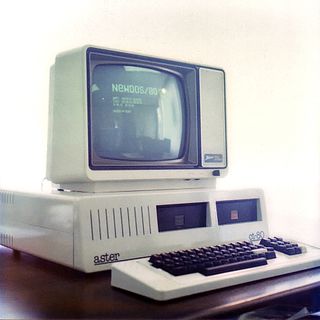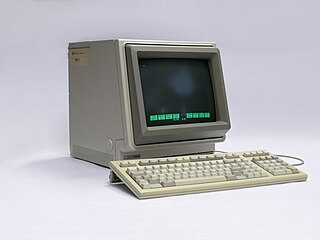
The Aster CT-80 is a 1982 personal computer developed by the small Dutch company MCP, was sold in its first incarnation as a kit for hobbyists. Later it was sold ready to use. It consisted of several Eurocard PCB's with DIN 41612 connectors, and a backplane all based on a 19-inch rack configuration. It was the first commercially available Dutch personal/home computer. The Aster computer could use the software written for the popular Tandy TRS-80 computer while fixing many of the problems of that computer, but it could also run CP/M software, with a large amount of free memory Transient Program Area, (TPA) and a full 80×25 display, and it could be used as a Videotext terminal. Although the Aster was a clone of the TRS-80 Model I it was in fact more compatible with the TRS-80 Model III and ran all the software of these systems including games. It also had a built-in speaker which was compatible with such games software.

The 8086 is a 16-bit microprocessor chip designed by Intel between early 1976 and June 8, 1978, when it was released. The Intel 8088, released July 1, 1979, is a slightly modified chip with an external 8-bit data bus, and is notable as the processor used in the original IBM PC design.

Video Graphics Array (VGA) is a video display controller and accompanying de facto graphics standard, first introduced with the IBM PS/2 line of computers in 1987, which became ubiquitous in the IBM PC compatible industry within three years. The term can now refer to the computer display standard, the 15-pin D-subminiature VGA connector, or the 640 × 480 resolution characteristic of the VGA hardware.
A blitter is a circuit, sometimes as a coprocessor or a logic block on a microprocessor, dedicated to the rapid movement and modification of data within a computer's memory. A blitter can copy large quantities of data from one memory area to another relatively quickly, and in parallel with the CPU, while freeing up the CPU's more complex capabilities for other operations. A typical use for a blitter is the movement of a bitmap, such as windows and icons in a graphical user interface or images and backgrounds in a 2D video game. The name comes from the bit blit operation of the 1973 Xerox Alto, which stands for bit-block transfer. A blit operation is more than a memory copy, because it can involve data that's not byte aligned, handling transparent pixels, and various ways of combining the source and destination data.

The Personal System/2 or PS/2 is IBM's second generation of personal computers. Released in 1987, it officially replaced the IBM PC, XT, AT, and PC Convertible in IBM's lineup. Many of the PS/2's innovations, such as the 16550 UART, 1440 KB 3.5-inch floppy disk format, 72-pin SIMMs, the PS/2 port, and the VGA video standard, went on to become standards in the broader PC market.

A coprocessor is a computer processor used to supplement the functions of the primary processor. Operations performed by the coprocessor may be floating-point arithmetic, graphics, signal processing, string processing, cryptography or I/O interfacing with peripheral devices. By offloading processor-intensive tasks from the main processor, coprocessors can accelerate system performance. Coprocessors allow a line of computers to be customized, so that customers who do not need the extra performance do not need to pay for it.

The Tandy 2000 is a personal computer introduced by Radio Shack in September 1983 based on the 8 MHz Intel 80186 microprocessor running MS-DOS. By comparison, the IBM PC XT used the older 4.77 MHz Intel 8088 processor, and the IBM PC/AT would later use the newer 6 MHz Intel 80286. Due to the 16-bit data bus and more efficient instruction decoding of the 80186, the Tandy 2000 ran significantly faster than other PC compatibles, and slightly faster than the PC AT. The Tandy 2000 was the company's first computer built around an Intel x86 series microprocessor; previous models used the Zilog Z80 and Motorola 6809 CPUs.

The Amstrad PC1512 was Amstrad's mostly IBM PC-compatible computer system, first manufactured in 1986. Next year a slight updated version named PC1640 was introduced. It was also marketed as PC6400, and Sinclair PC500. Schneider branded machines for the German market also exists.

HP-150 was a compact, powerful and innovative computer made by Hewlett-Packard in 1983. It was based on the Intel 8088 CPU and was one of the world's earliest commercialized touch screen computers. Like other "workalike" IBM PC clones of the time, despite running customized MS-DOS versions 2.01, 2.11 and 3.20, the machine was not IBM PC DOS compatible. Its 8088 CPU, rated at 8 MHz, was faster than the 4.77 MHz CPUs used by the IBM PC of that period. Using add-on cards, main memory could be increased from 256 KB to 640 KB. However, its mainboard did not have a slot for the optional Intel 8087 math coprocessor due to space constraints. An HP-150 with an optional hard disk was called HP Touchscreen MAX.

The Professional 325 (PRO-325), Professional 350 (PRO-350), and Professional 380 (PRO-380) are PDP-11 compatible microcomputers. The Pro-325/350 were introduced in 1982 and the Pro-380 in 1985 by Digital Equipment Corporation (DEC) as high-end competitors to the IBM PC.
The Apricot PC is a personal computer produced by Apricot Computers, then still known as Applied Computer Techniques or ACT. Released in late 1983, it was ACT's first independently developed microcomputer, following on from the company's role of marketing and selling the ACT Sirius 1, and was described as "the first 16-bit system to be Sirius-compatible, rather than IBM-compatible", indicating the influence that the Sirius 1 had in the United Kingdom at the time.

The Leading Edge Model D is an IBM clone first released by Leading Edge Hardware in July 1985. It was initially priced at $1,495 and configured with dual 5.25" floppy drives, 256 KB of RAM, and a monochrome monitor. It was manufactured by South Korean conglomerate Daewoo and distributed by Canton, Massachusetts-based Leading Edge. Engineer Stephen Kahng spent about four months designing the Model D at a cost of $200,000. Kahng later became CEO of Macintosh clone maker Power Computing.

The Commodore A1060 Sidecar is an expansion hardware device developed by Commodore and released in 1986 for the Amiga 1000 computer. It features a complete PC XT-clone system mounted in an expansion case which connected to the expansion bus on the right side of the Amiga 1000 computer, sitting beside it similar to a motorcycle's sidecar, hence the name.
The Z-100 computer is a personal computer made by Zenith Data Systems (ZDS). It was a competitor to the IBM PC.

IBM 5550 is a personal computer series that IBM marketed in Japan, Korea, Taiwan and China in the 1980s and 1990s, for business use customers. In Japan, it was introduced in 1983 and promoted as "Multistation 5550 (マルチステーション5550)" because it had three roles in one machine: a PC, a word processing machine which was traditionally marketed as a machine different from a PC in Japan, and an IBM-host attached terminal.

The APC was a series of business microcomputers released outside of Japan by the NEC Corporation. The series comprised the APC, the APC II and APC III, international versions of models from the Japanese NEC N5200 series(jp).
The ICL DRS was a range of departmental computers from International Computers Limited (ICL). Standing originally for Distributed Resource System, the full name was later dropped in favour of the abbreviation.
The Texas Instruments Professional Computer and the Texas Instruments Professional Portable Computer (TIPPC) are personal computers produced by Texas Instruments that were both released on January 31, 1983, and discontinued around 1985; the TIPC is a desktop PC and the TIPPC is a portable version that is fully compatible with it. Both computers were most often used by white-collar information workers and professionals that needed to gather, manipulate and transmit information.
The Thomson TO16 or Thomson TO16PC is a PC compatible personal computer introduced by French company Thomson SA in 1987, with prices ranging from 9000 to 16000 FF depending on the version.

The Tandy 1400 LT is the first MS-DOS compatible laptop sold by Tandy Corporation. Introduced in November 1987, it had two 3.5 inch floppy drives and a flip-up monochrome LCD screen, powered by an internal battery.














